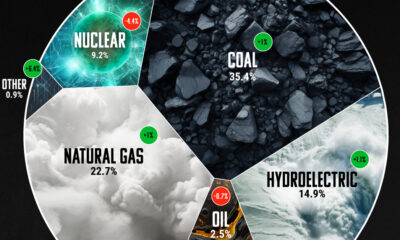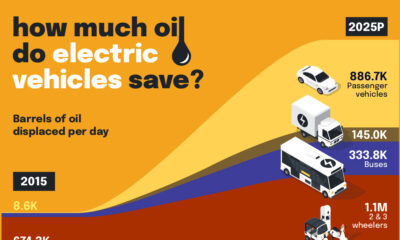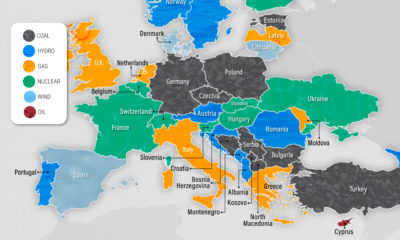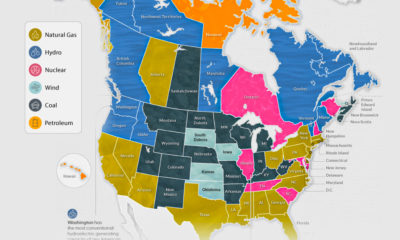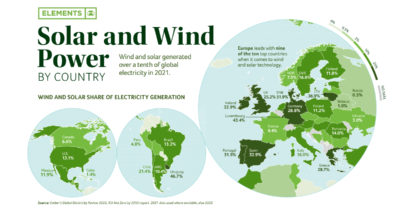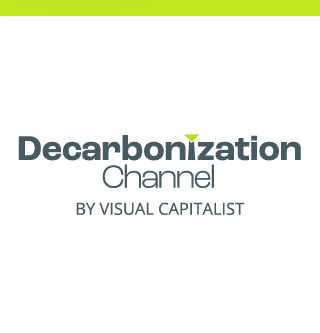Urbanization
Mapped: Energy Consumption Per Capita Around the World
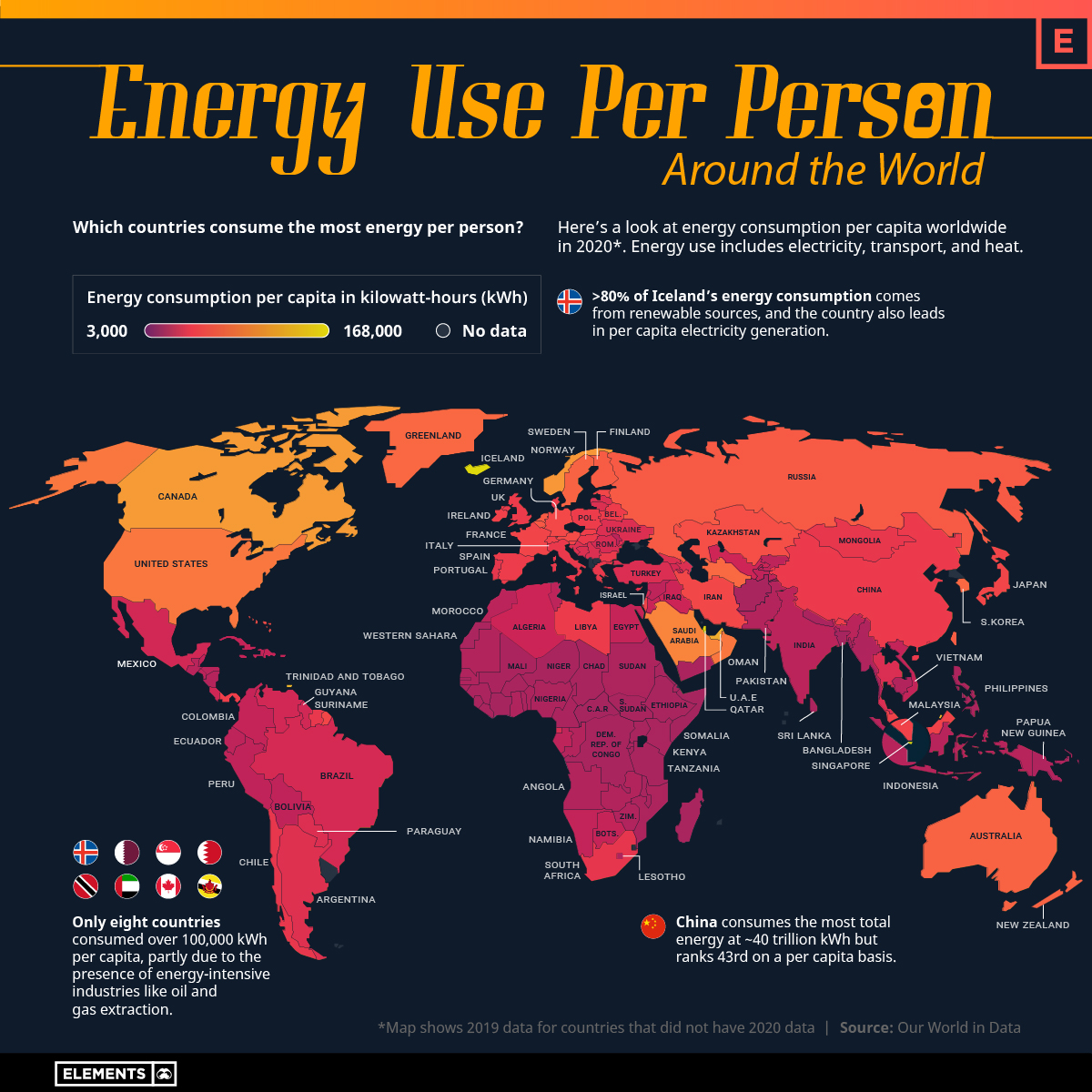
Mapping Global Energy Consumption Per Capita
In the four decades since 1980, global energy consumption doubled from 77 trillion kilowatt-hours (kWh) to nearly 155 trillion kWh.
But despite soaring energy demand from emerging economies, energy consumption per person only grew by around 14%.
So, which countries consume the most energy per capita today?
The above infographic maps global per capita energy consumption in 2020 using data from Our World in Data. Energy consumption includes electricity, transport, and heating.
The Energy Consumption Leaderboard
The top 10 countries by energy consumption per capita are relatively wealthy and heavily industrialized.
| Country | Year of data | Energy consumption per capita (kWh) |
|---|---|---|
| Iceland | 2020 | 167,175 |
| Qatar | 2020 | 165,044 |
| Singapore | 2020 | 162,192 |
| Bahrain | 2019 | 145,193 |
| Trinidad and Tobago | 2020 | 123,800 |
| Brunei | 2019 | 121,637 |
| United Arab Emirates | 2020 | 117,686 |
| Canada | 2020 | 100,310 |
| Norway | 2020 | 98,879 |
| Kuwait | 2020 | 98,021 |
| United States Virgin Islands | 2019 | 95,010 |
| Malta | 2019 | 91,685 |
| Saudi Arabia | 2020 | 84,262 |
| Faeroe Islands | 2019 | 80,177 |
| New Caledonia | 2019 | 78,606 |
| Oman | 2020 | 74,514 |
| United States | 2020 | 73,677 |
| Turkmenistan | 2020 | 64,639 |
| Saint Pierre and Miquelon | 2019 | 64,130 |
| South Korea | 2020 | 63,865 |
| Luxembourg | 2020 | 63,726 |
| Greenland | 2019 | 62,156 |
| Europe | 2020 | 28,617 |
| European Union (27) | 2020 | 34,772 |
| Falkland Islands | 2019 | 61,362 |
| Australia | 2020 | 60,660 |
| Sweden | 2020 | 60,494 |
| Taiwan | 2020 | 56,199 |
| Finland | 2020 | 54,962 |
| Netherlands | 2020 | 54,673 |
| Russia | 2020 | 53,895 |
| Belgium | 2020 | 52,510 |
| Bermuda | 2019 | 51,713 |
| Cayman Islands | 2019 | 51,435 |
| Aruba | 2019 | 51,179 |
| New Zealand | 2020 | 48,414 |
| Seychelles | 2019 | 47,768 |
| Kazakhstan | 2020 | 45,950 |
| Guam | 2019 | 44,771 |
| Austria | 2020 | 42,676 |
| Bahamas | 2019 | 41,170 |
| Germany | 2020 | 40,153 |
| Czechia | 2020 | 39,883 |
| Iran | 2020 | 39,785 |
| Estonia | 2020 | 39,024 |
| Japan | 2020 | 37,403 |
| France | 2020 | 37,041 |
| Slovenia | 2020 | 35,850 |
| Malaysia | 2020 | 35,296 |
| Ireland | 2020 | 34,600 |
| Switzerland | 2020 | 34,597 |
| Hong Kong | 2020 | 34,430 |
| Israel | 2020 | 33,625 |
| Slovakia | 2020 | 31,697 |
| Antigua and Barbuda | 2019 | 31,385 |
| Puerto Rico | 2019 | 29,546 |
| Spain | 2020 | 29,541 |
| Poland | 2020 | 29,453 |
| Bhutan | 2019 | 29,338 |
| Panama | 2019 | 28,998 |
| Belarus | 2020 | 28,871 |
| Denmark | 2020 | 28,314 |
| United Kingdom | 2020 | 28,211 |
| China | 2020 | 28,072 |
| Cook Islands | 2019 | 27,921 |
| Hungary | 2020 | 27,834 |
| Bulgaria | 2020 | 27,582 |
| Montserrat | 2019 | 27,374 |
| Italy | 2020 | 26,936 |
| Greece | 2020 | 26,659 |
| American Samoa | 2019 | 26,024 |
| Libya | 2019 | 25,864 |
| Turks and Caicos Islands | 2019 | 25,775 |
| Portugal | 2020 | 25,405 |
| Lithuania | 2020 | 25,365 |
| Nauru | 2019 | 24,818 |
| Martinique | 2019 | 24,598 |
| Barbados | 2019 | 24,537 |
| Mongolia | 2019 | 24,338 |
| Suriname | 2019 | 24,136 |
| Macao | 2019 | 23,858 |
| British Virgin Islands | 2019 | 23,486 |
| Cyprus | 2020 | 23,358 |
| Chile | 2020 | 23,348 |
| Mauritius | 2019 | 23,278 |
| Latvia | 2019 | 23,051 |
| South Africa | 2020 | 22,959 |
| Serbia | 2019 | 22,784 |
| Montenegro | 2019 | 22,650 |
| Croatia | 2020 | 22,105 |
| Guadeloupe | 2019 | 21,483 |
| Laos | 2019 | 21,449 |
| Latvia | 2020 | 21,370 |
| Saint Kitts and Nevis | 2019 | 21,074 |
| Bosnia and Herzegovina | 2019 | 21,068 |
| Ukraine | 2020 | 21,048 |
| Turkey | 2020 | 20,716 |
| Thailand | 2020 | 20,370 |
| Niue | 2019 | 19,975 |
| Argentina | 2020 | 19,352 |
| Romania | 2020 | 19,220 |
| Georgia | 2019 | 18,547 |
| Paraguay | 2019 | 18,398 |
| Maldives | 2019 | 17,493 |
| Azerbaijan | 2020 | 17,037 |
| French Polynesia | 2019 | 16,894 |
| Equatorial Guinea | 2019 | 16,880 |
| French Guiana | 2019 | 16,526 |
| Reunion | 2019 | 15,931 |
| Brazil | 2020 | 15,692 |
| Lebanon | 2019 | 15,614 |
| Uzbekistan | 2020 | 15,542 |
| Armenia | 2019 | 15,538 |
| Saint Lucia | 2019 | 14,909 |
| Jamaica | 2019 | 14,563 |
| Algeria | 2020 | 14,561 |
| Guyana | 2019 | 14,246 |
| Iraq | 2020 | 14,246 |
| Venezuela | 2020 | 14,082 |
| Mexico | 2020 | 13,952 |
| North Macedonia | 2020 | 13,582 |
| Costa Rica | 2019 | 13,159 |
| Vietnam | 2020 | 11,669 |
| Grenada | 2019 | 11,661 |
| Jordan | 2019 | 11,484 |
| Dominican Republic | 2019 | 11,435 |
| Albania | 2019 | 11,266 |
| Dominica | 2019 | 10,994 |
| Ecuador | 2020 | 10,158 |
| Botswana | 2019 | 9,992 |
| Egypt | 2020 | 9,899 |
| Colombia | 2020 | 9,648 |
| Fiji | 2019 | 9,642 |
| Cuba | 2019 | 9,608 |
| Belize | 2019 | 9,247 |
| Saint Helena | 2019 | 8,871 |
| Namibia | 2019 | 8,738 |
| Peru | 2020 | 8,400 |
| Saint Vincent and the Grenadines | 2019 | 8,154 |
| Tajikistan | 2019 | 8,102 |
| Samoa | 2019 | 7,959 |
| Bolivia | 2019 | 7,940 |
| Gabon | 2019 | 7,850 |
| Cape Verde | 2019 | 7,776 |
| Indonesia | 2020 | 7,753 |
| Syria | 2019 | 7,325 |
| El Salvador | 2019 | 7,070 |
| Tonga | 2019 | 6,694 |
| Morocco | 2020 | 6,607 |
| India | 2020 | 6,438 |
| Micronesia | 2019 | 6,334 |
| Honduras | 2019 | 5,803 |
| Guatemala | 2019 | 5,689 |
| Eswatini | 2019 | 5,678 |
| Congo | 2019 | 4,735 |
| Philippines | 2020 | 4,626 |
| Nicaragua | 2019 | 4,372 |
| Pakistan | 2020 | 4,369 |
| Sri Lanka | 2020 | 4,237 |
| Cambodia | 2019 | 3,994 |
| Palestine | 2019 | 3,991 |
| Mauritania | 2019 | 3,976 |
| Africa | 2020 | 3,851 |
| North Korea | 2019 | 3,696 |
| Angola | 2019 | 3,430 |
| Sao Tome and Principe | 2019 | 3,412 |
| Zambia | 2019 | 3,398 |
| Zimbabwe | 2019 | 3,375 |
| Papua New Guinea | 2019 | 3,316 |
| Ghana | 2019 | 3,294 |
| Vanuatu | 2019 | 3,188 |
| Myanmar | 2019 | 3,130 |
| Kiribati | 2019 | 2,739 |
| Senegal | 2019 | 2,703 |
| Bangladesh | 2020 | 2,685 |
| Djibouti | 2019 | 2,598 |
| Benin | 2019 | 2,483 |
| Nigeria | 2019 | 2,481 |
| Cote d'Ivoire | 2019 | 2,417 |
| Mozambique | 2019 | 2,377 |
| Sudan | 2019 | 2,360 |
| Lesotho | 2019 | 2,293 |
| Solomon Islands | 2019 | 2,038 |
| Western Sahara | 2019 | 1,868 |
| Kenya | 2019 | 1,849 |
| Cameroon | 2019 | 1,818 |
| Timor | 2019 | 1,682 |
| Yemen | 2019 | 1,598 |
| Comoros | 2019 | 1,567 |
| Nepal | 2019 | 1,530 |
| Mali | 2019 | 1,289 |
| Guinea | 2019 | 1,212 |
| Togo | 2019 | 1,205 |
| Haiti | 2019 | 1,164 |
| Liberia | 2019 | 1,112 |
| Gambia | 2019 | 1,039 |
| Tanzania | 2019 | 978 |
| Burkina Faso | 2019 | 952 |
| Afghanistan | 2019 | 946 |
| Eritrea | 2019 | 945 |
| Ethiopia | 2019 | 944 |
| Uganda | 2019 | 862 |
| Guinea-Bissau | 2019 | 721 |
| South Sudan | 2019 | 705 |
| Madagascar | 2019 | 677 |
| Malawi | 2019 | 530 |
| Sierra Leone | 2019 | 528 |
| Rwanda | 2019 | 500 |
| Chad | 2019 | 462 |
| Niger | 2019 | 451 |
| Democratic Republic of Congo | 2019 | 403 |
| Central African Republic | 2019 | 328 |
| Burundi | 2019 | 319 |
| Somalia | 2019 | 236 |
Iceland tops the list and is also the leading generator of electricity per capita. Thanks to the country’s abundance of geothermal resources, geothermal and hydropower plants account for more than 99% of Iceland’s electricity generation.
Many of the top 10 countries are large energy producers or industry-heavy economies. For example, Saudi Arabia, Canada, Kuwait, Norway, and Qatar are among the world’s 15 largest oil-producing countries. Similarly, Trinidad and Tobago is the largest oil and gas producer in the Caribbean and is one of the largest exporters of ammonia globally.
The presence of energy-intensive industries like oil and gas extraction is likely a major factor influencing total and per-person energy use in these countries.
Why is Tiny Iceland So Big on Energy Use?
Why does Iceland use so much energy per person?
Let’s take a look at Iceland’s colossal industrial energy consumption, to see where energy goes:
| Sector / Industry | 2019 energy consumption* (thousand kWh) | % of total |
|---|---|---|
| Aluminum smelters | 12,490,266 | 65.9% |
| Services | 1,127,615 | 5.9% |
| Data centers | 990,097 | 5.2% |
| Ferroalloy industry | 897,846 | 4.7% |
| Residential | 847,713 | 4.5% |
| Utilities | 781,707 | 4.1% |
| Aluminum foil industry | 473,723 | 2.5% |
| Agriculture | 231,236 | 1.2% |
| Fisheries | 78,940 | 0.4% |
| Other industries | 1,038,410 | 5.5% |
| Total | 18,957,553 | 100% |
*Energy consumption excludes losses.
Source: Orkustofnunn – National Energy Authority of Iceland
Iceland’s three Aluminum smelters—Alcoa, Rio Tinto Alcan, and Century Aluminum—consume more energy than all other sectors combined, and account for 30% of the country’s carbon dioxide emissions. Iceland isn’t particularly rich in bauxite (the raw material used to make aluminum), but cheap and clean electricity are big incentives for aluminum smelters to set up operations on the island.
For similar reasons, Iceland is also a popular destination for data centers and bitcoin mining. The year-round cool climate lowers cooling costs for thousands of computers running around the clock, and clean grid electricity minimizes their carbon footprint.
Overall, it’s not surprising that the residential sector is among the smaller consumers of energy, despite the importance of home heating in a cool climate. Iceland’s industries, especially aluminum smelting, make up the bulk of its energy use, pushing the overall per-person use above all other countries.
The Bottom 10 Countries
Countries at the bottom end of the list are among the world’s least-developed economies, with relatively lower GDP per capita numbers.
| Country | 2019 Energy consumption per capita (kWh) | GDP per capita (2020, current US$) |
|---|---|---|
| Madagascar | 677 | $471.5 |
| Malawi | 530 | $636.8 |
| Sierra Leone | 528 | $509.4 |
| Rwanda | 500 | $797.9 |
| Chad | 462 | $659.3 |
| Niger | 451 | $567.7 |
| Democratic Republic of Congo | 403 | $544.0 |
| Central African Republic | 328 | $492.8 |
| Burundi | 319 | $239.0 |
| Somalia | 236 | $438.3 |
These countries consumed significantly less energy per capita compared to the global average of 19,836 kWh. In a stark contrast to the countries topping the list, their per capita GDPs are all lower than $1,000.
As economies develop, villages get electrified, megacities emerge, and industries grow, leading to higher overall energy consumption. On a global scale, if economic growth continues, energy consumption per capita is likely to continue its steady increase.
Urbanization
Ranked: The 20 Most Air-Polluted Cities on Earth
Using 2022 average PM2.5 concentrations, we rank the most polluted cities in the world.
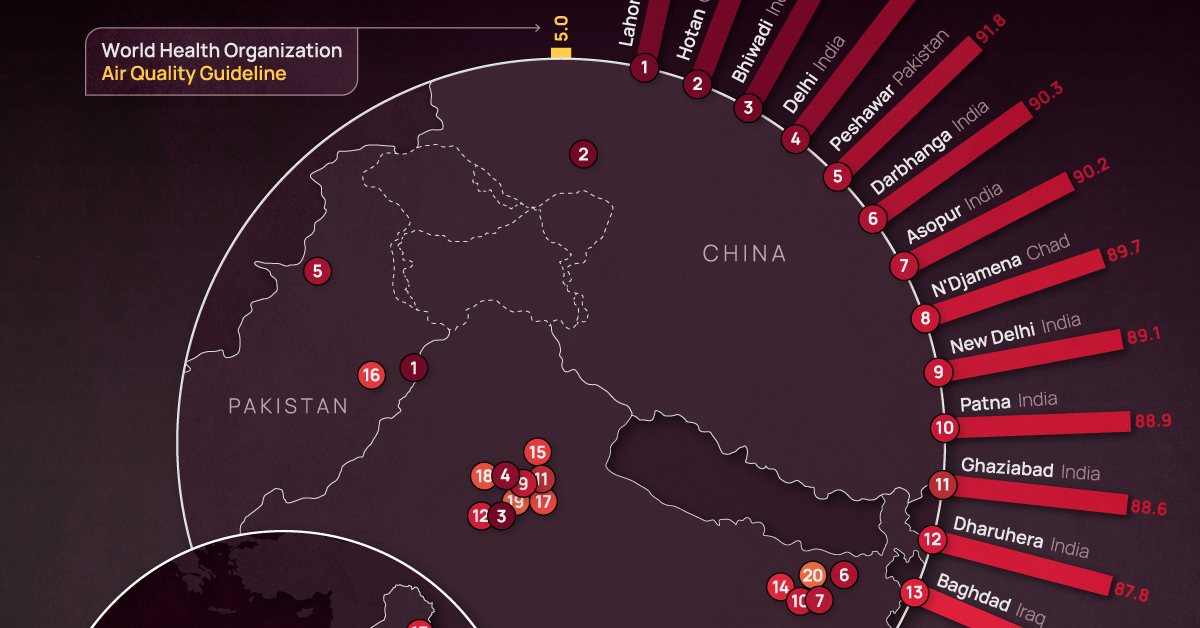
Ranked: The 20 Most Air-Polluted Cities on Earth
According to the World Health Organization (WHO), almost the entire global population (99%) breathes air that exceeds WHO air quality limits.
In the above map, we use 2022 average PM2.5 concentrations from IQAir’s World Air Quality Report to visualize the most air-polluted major cities in the world.
World’s Air Pollution Hot Spots
As one of the standard air quality indicators used by the WHO, the PM2.5 concentration refers to the quantity of fine particulate matter with a diameter of 2.5 micrometers or less in a given volume of air.
Fine particulate matter that is this small can penetrate the lungs when inhaled and enter the bloodstream, affecting all major organs.
Based on annual average PM2.5 concentrations (μg/m³) in 2022, here are the most polluted cities in the world.
| Rank | City | 2022 average PM2.5 concentration (μg/m³) |
|---|---|---|
| 1 | 🇵🇰 Lahore, Pakistan | 97.4 |
| 2 | 🇨🇳 Hotan, China | 94.3 |
| 3 | 🇮🇳 Bhiwadi, India | 92.7 |
| 4 | 🇮🇳 Delhi, India | 92.6 |
| 5 | 🇵🇰 Peshawar, Pakistan | 91.8 |
| 6 | 🇮🇳 Darbhanga, India | 90.3 |
| 7 | 🇮🇳 Asopur, India | 90.2 |
| 8 | 🇹🇩 N'Djamena, Chad | 89.7 |
| 9 | 🇮🇳 New Delhi, India | 89.1 |
| 10 | 🇮🇳 Patna, India | 88.9 |
| 11 | 🇮🇳 Ghaziabad, India | 88.6 |
| 12 | 🇮🇳 Dharuhera, India | 87.8 |
| 13 | 🇮🇶 Baghdad, Iraq | 86.7 |
| 14 | 🇮🇳 Chapra, India | 85.9 |
| 15 | 🇮🇳 Muzaffarnagar, India | 85.5 |
| 16 | 🇵🇰 Faisalabad, Pakistan | 84.5 |
| 17 | 🇮🇳 Greater Noida, India | 83.2 |
| 18 | 🇮🇳 Bahadurgarh, India | 82.2 |
| 19 | 🇮🇳 Faridabad, India | 79.7 |
| 20 | 🇮🇳 Muzaffarpur, India | 79.2 |
With numbers these high, the concentration of some or all of the following pollutants are at dangerous levels in these cities:
- Ground-level ozone
- Particulate matter
- Carbon monoxide
- Sulfur dioxide
- Nitrogen dioxide
At the top of the list, Lahore in Pakistan has a combination of high vehicle and industrial emissions, as well as smoke from brick kilns, crop residue, general waste burning, and dust from construction sites.
Air pollution levels can also be impacted by practices such as large-scale tree removal in order to build new roads and buildings.
As a result of its growing population and rapidly expanding industrial sector, India has 14 cities on the list, outpacing China, formerly considered the world’s number one air pollution source.
The only African country on the list, Chad, experienced severe dust storms in 2022 that resulted in an 18% increase in PM2.5 concentration in 2022 compared to the previous year.
The Cost of Poor Air Quality
Poor air quality is one of the leading causes of early deaths worldwide, just behind high blood pressure, tobacco use, and poor diet.
According to a 2020 study by the Health Effects Institute, 6.67 million people died as a result of air pollution in 2019.
In addition to the millions of premature deaths each year, the global cost of health damages associated with air pollution currently sits at $8.1 trillion.
Urbanization
Visualizing the World’s Largest Steel-Producing Countries
China has dominated global steel production the past few decades, but how did the country get here, and is its production growth over?
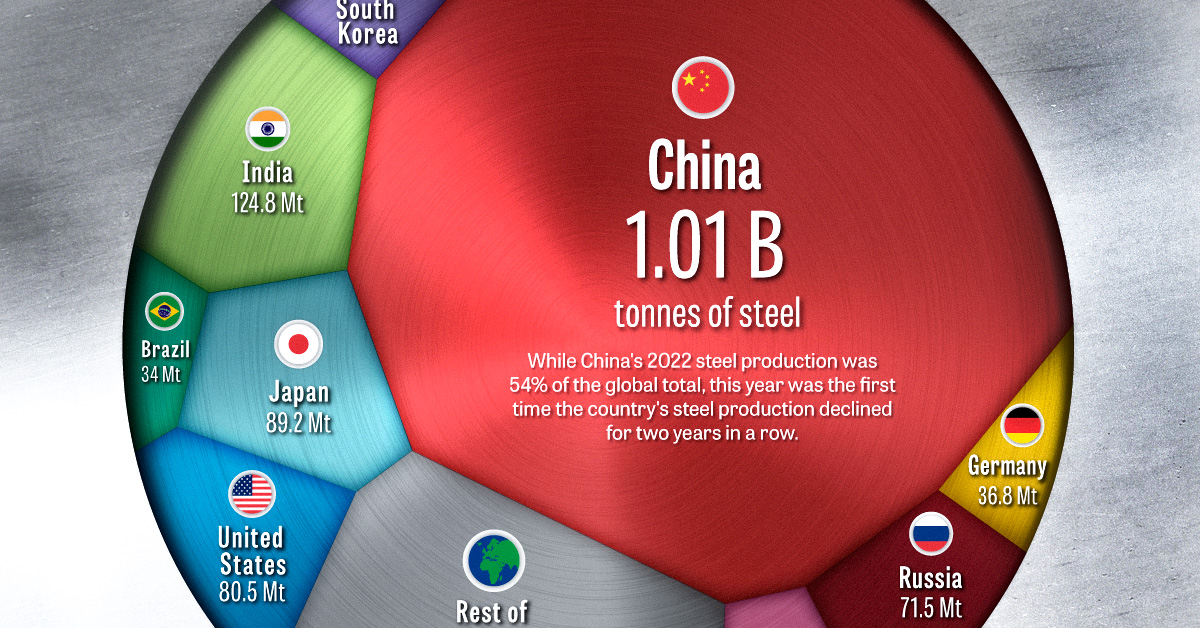
The Largest Steel-Producing Countries: Visualized
Steel is a critical component of modern industry and economy, essential for the construction of buildings, automobiles, and many other appliances and infrastructure used in our daily lives.
This graphic uses data from the World Steel Association to visualize the world’s top steel-producing countries, and highlights China’s ascent to the top, as it now makes up more than half of the world’s steel production.
The State of Global Steel Production
Global steel production in 2022 reached 1,878 million tonnes, barely surpassing the pre-pandemic production of 1,875 million tonnes in 2019.
| Country | 2022 Production (in million tonnes) | Annual Production Change | Global Share |
|---|---|---|---|
| 🇨🇳 China | 1013.0 | -2.0% | 53.9% |
| 🇮🇳 India | 124.8 | 5.3% | 6.6% |
| 🇯🇵 Japan | 89.2 | -7.9% | 4.8% |
| 🇺🇸 United States | 80.5 | -6.5% | 4.3% |
| 🇷🇺 Russia | 71.5 | -5.8% | 3.8% |
| 🇰🇷 South Korea | 65.9 | -6.9% | 3.5% |
| 🇩🇪 Germany | 36.8 | -8.8% | 2.0% |
| 🇹🇷 Türkiye | 35.1 | -15.0% | 1.9% |
| 🇧🇷 Brazil | 34.0 | -6.5% | 1.8% |
| 🇮🇷 Iran | 30.6 | 6.8% | 1.6% |
| 🇮🇹 Italy | 21.6 | -13.0% | 1.1% |
| 🇹🇼 Taiwan | 20.7 | -12.1% | 1.1% |
| 🇻🇳 Vietnam | 20.0 | -15.0% | 1.1% |
| 🇲🇽 Mexico | 18.2 | -1.9% | 1.0% |
| 🇮🇩 Indonesia | 15.6 | 8.3% | 0.8% |
| Rest of World | 201.0 | -11.2% | 10.7% |
| World Total | 1878.5 | -3.9% | 100.0% |
2022’s steel production marked a significant reduction compared to the post-pandemic rebound of 1,960 million tonnes in 2021, with a year-over-year decline of 4.2%–the largest drop since 2009, and prior to that, 1991.
This decline was spread across many of the world’s top steel producers, with only three of the top fifteen countries, India, Iran, and Indonesia, increasing their yearly production. Most of the other top steel-producing countries saw annual production declines of more than 5%, with Turkey, Italy, Taiwan, and Vietnam’s production all declining by double digits.
Even the world’s top steel-producing nation, China, experienced a modest 2% decline, which due to the country’s large production amounted to a decline of 19.8 million tonnes, more than many other nations produce in a year.
Despite India, the world’s second-largest steel producer, increasing its production by 5.3%, the country’s output still amounts to just over one-tenth of the steel produced by China.
China’s Meteoric Rise in Steel Production
Although China dominates the world’s steel production with more than a 54% share today, this hasn’t always been the case.
In 1967, the World Steel Association’s first recorded year of steel production figures, China only produced an estimated 14 million tonnes, making up barely 3% of global output. At that time, the U.S. and the USSR were competing as the world’s top steel producers at 115 and 102 million tonnes respectively, followed by Japan at 62 million tonnes.
Almost three decades later in 1996, China had successively overtaken Russia, the U.S., and Japan to become the top steel-producing nation with 101 million tonnes of steel produced that year.
The early 2000s marked a period of rapid growth for China, with consistent double-digit percentage increases in steel production each year.
The Recent Decline in China’s Steel Production
Since the early 2000s, China’s average annual growth in steel production has slowed to 3.4% over the last decade (2013-2022), a considerable decline compared to the previous decade’s (2003-2012) 15.2% average annual growth rate.
The past couple of years have seen China’s steel production decline, with 2021 and 2022 marking the first time the country’s production fell for two consecutive years in a row.
While it’s unlikely China will relinquish its position as the top steel-producing nation anytime soon, it remains to be seen whether this recent decline marks the beginning of a new trend or just a brief deviation from the country’s consistent production growth.
-

 Electrification3 years ago
Electrification3 years agoRanked: The Top 10 EV Battery Manufacturers
-

 Electrification2 years ago
Electrification2 years agoThe Key Minerals in an EV Battery
-

 Real Assets3 years ago
Real Assets3 years agoThe World’s Top 10 Gold Mining Companies
-

 Misc3 years ago
Misc3 years agoAll the Metals We Mined in One Visualization
-

 Electrification3 years ago
Electrification3 years agoThe Biggest Mining Companies in the World in 2021
-

 Energy Shift2 years ago
Energy Shift2 years agoWhat Are the Five Major Types of Renewable Energy?
-

 Electrification2 years ago
Electrification2 years agoMapped: Solar Power by Country in 2021
-

 Electrification2 years ago
Electrification2 years agoThe World’s Largest Nickel Mining Companies










